Description
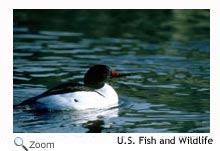 The common merganser is a diving duck that is 22-28 inches in length with a wingspan of 34 inches. It has a long, thin, serrated bill and brown eyes. The male's bill is reddish-orange and the female's bill is orange. The common merganser is a diving duck that is 22-28 inches in length with a wingspan of 34 inches. It has a long, thin, serrated bill and brown eyes. The male's bill is reddish-orange and the female's bill is orange.
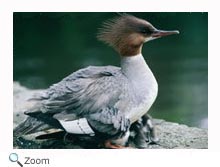 Both the male and the female have a crest of feathers on their heads. The crest is more visible on the female. The male has a white breast, neck, and sides. He has
an iridescent
greenish-black head and neck and a black back and tail. The female has a gray body, a reddish-brown head and neck, and a white chin. Both the male and the female have a white patch on their wings that is visible when they are in flight. Both the male and the female have a crest of feathers on their heads. The crest is more visible on the female. The male has a white breast, neck, and sides. He has
an iridescent
greenish-black head and neck and a black back and tail. The female has a gray body, a reddish-brown head and neck, and a white chin. Both the male and the female have a white patch on their wings that is visible when they are in flight.
Range 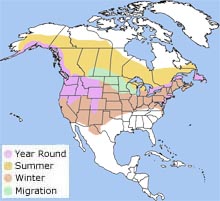 The common merganser breeds from Alaska east to Newfoundland and south to California, New Mexico, the Great Lakes region, and New England. It winters from southern Canada south to northern Mexico. It is also found in Europe and Asia. The common merganser breeds from Alaska east to Newfoundland and south to California, New Mexico, the Great Lakes region, and New England. It winters from southern Canada south to northern Mexico. It is also found in Europe and Asia.
Habitat
During the breeding season, the common merganser is found on wooded rivers and lakes. It winters on lakes, rivers, bays, and estuaries.
| |
Diet
 The common merganser dives for prey like
fish, mollusks, and crustaceans. It commonly preys on fish like
trout, small salmon, perch, minnows, and eels.
The serrated edges of the common merganser's bill are like the teeth of a saw! They help the merganser get a good hold on the fish it catches so the fish can't wiggle away. The common merganser is sometimes called the sawbill! The common merganser dives for prey like
fish, mollusks, and crustaceans. It commonly preys on fish like
trout, small salmon, perch, minnows, and eels.
The serrated edges of the common merganser's bill are like the teeth of a saw! They help the merganser get a good hold on the fish it catches so the fish can't wiggle away. The common merganser is sometimes called the sawbill!
Life Cycle 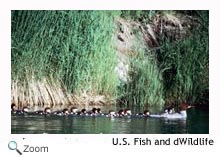 Male and female common mergansers form pairs in the late winter or early spring. The female lays
6-12 eggs in a tree cavity lined with down. Common mergansers frequently use woodpecker holes for their nests. The female sometimes makes her nest
nest in a rock crevice, a hole in the ground, in a hollow log, or under tree roots.
Nests are usually near the water. The female incubates the eggs, which hatch in 28-35 days. The male stays near the nest until incubation begins. The ducklings leave the nest a day or two after hatching and dabble in the water for insects. By the time they are a few weeks old, they begin diving for larger prey. Male and female common mergansers form pairs in the late winter or early spring. The female lays
6-12 eggs in a tree cavity lined with down. Common mergansers frequently use woodpecker holes for their nests. The female sometimes makes her nest
nest in a rock crevice, a hole in the ground, in a hollow log, or under tree roots.
Nests are usually near the water. The female incubates the eggs, which hatch in 28-35 days. The male stays near the nest until incubation begins. The ducklings leave the nest a day or two after hatching and dabble in the water for insects. By the time they are a few weeks old, they begin diving for larger prey.
Behavior
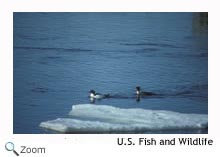 The common merganser is a good swimmer and diver, but it is awkward on land. It runs across the water to build up enough speed to take off and fly. The common merganser is a good swimmer and diver, but it is awkward on land. It runs across the water to build up enough speed to take off and fly.
|

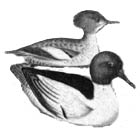


 The common merganser breeds from Alaska east to Newfoundland and south to California, New Mexico, the Great Lakes region, and New England. It winters from southern Canada south to northern Mexico. It is also found in Europe and Asia.
The common merganser breeds from Alaska east to Newfoundland and south to California, New Mexico, the Great Lakes region, and New England. It winters from southern Canada south to northern Mexico. It is also found in Europe and Asia.


